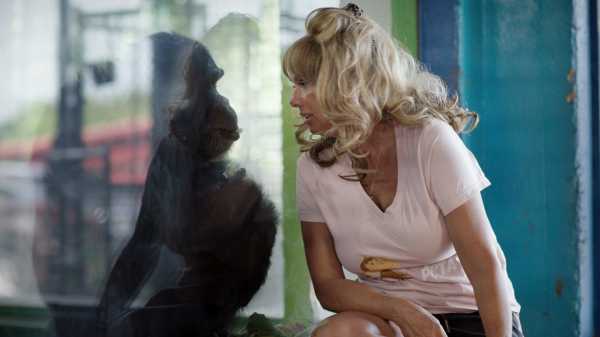
Save this storySave this storySave this storySave this story
For me, the ur-story of humankind’s interaction with other animals is the one that comes early in the Book of Genesis. God parades each species before Adam in a long and surely lively procession—cattle and fowl, the beasts of the field—and delegates to the first man the job of giving them their names. There’s nothing in that short passage about ownership, or using them for food or company. Just the taxonomical, almost administrative duty of sorting and naming. There’s something solemn and intimate about that idea: to look a creature—someone—in the eyes and, as steward or sovereign, bestow a name is to acknowledge that being as a member of a family, to recognize an individual’s dignity. It’s the first thing we do, after all, with our own kids.
Maybe that’s why it’s so haunting to watch the human beings depicted in the HBO docuseries “Chimp Crazy” as they carry on their relationships with captive chimpanzees. The chimps have names: Travis and Buck and Tonka. Accordingly, they’re trained by their owners—or . . . mothers? friends? how about enslavers?—to playact as family members. They sit at the table and eat food fit for people—there’s lots of McDonald’s in the show’s feeding scenes—and wear outfits for children in bright colors.
One of these chimp people, in trouble with the law, stands before the steps of a courthouse and proclaims to love her animal more than she loves her own children. Later, we meet a son of hers, and he confirms that it’s true. In her house, there’s a sign: “Surround yourself with monkeys not negativity.” Many of the “primates”—for people offering chimps an equal seat at the table of human domesticity, this scientific word gets used in casual conversation a lot—have made money by appearing in big-budget films, not unlike a little brother who gets a gig shooting cute commercials. Yes, he’s talented, but when he’s at home he’s like anybody else. One daughter claims that she can’t imagine growing up without this sweet great ape for a sibling. Life, she says, would’ve been so different without him. Yeah, I bet. This four-part series might well have been whittled down into an efficient, increasingly sad feature film, but it earns its length—even before its content gets pitch-dark—by the sheer weirdness of its many anecdotes. One lady takes her chimp to local restaurants and dresses him in the clothes of her dead husband.
The family façade slips quickly, though. Asked about prices, one famous chimp breeder named Connie Casey can produce the figure almost instantaneously: a baby chimp goes for sixty-five thousand dollars. That’s enough to make you wonder, scene after scene, where these strange people get the money to support their odd habit. Each roomful of cages is like Jay Leno’s garage, full of rare Porsches. The chimps are commodities: besides acting, they show up at kids’ parties and make for a thrillingly humanoid field-trip visit. A house stinking of chimp is a “reserve” if you squint. But, even if the chimps aren’t just like us, they are persons of a kind. They get sad and weird and flash their personalities under strain.
Chimps don’t like being locked up for days at a time, it turns out. One of the most galling stories in “Chimp Crazy”—a high bar, you’ll soon realize—is about the aforementioned Travis. He was in TV shows and commercials, and achieved a kind of local fame in Stamford, Connecticut, where he lived with his owner, Sandra Herold. He grew large, well beyond the age of cute companionship—that budding time when a young knuckle-dragger might look chic on the shoulder of Michael Jackson. Now almost two hundred pounds, Travis stepped away from the spotlight and was kept in confinement. “He went from being the famous chimp to the unseen chimp,” a friend of Herold’s says under interview.
In 2009, a close friend of Herold’s, Charla Nash, came over one day to help Herold get Travis, who had got loose, back into the house. He maimed her badly, gouging out both of her eyes, and, according to Herold’s cries during a call to 911, “ripped her face off” and was “eating her.” As Nash—who somehow survived—later said, “He did a number on me.” The cop who showed up on the scene describes Travis approaching his car, shaking it, and then ripping off the door. But the animal didn’t immediately attack—instead, according to the officer, the chimp communicated with him telepathically. The officer doesn’t seem insane. “I swear this is true,” he says. “I didn’t hear it but it was, like, a connection. And he said to me: ‘Please do it . . . I can’t take it anymore.’ ” Do it, as in Kill me. Having wilded out, Travis opted for suicide by cop. To paraphrase a Chris Rock joke about “trained” animals and their tenuous relationship to society: That monkey didn’t go crazy. That monkey went monkey.
The real narrative thrust of “Chimp Crazy,” however, has to do with the case of Tonia Haddix, who fell in love with the chimp world under the influence—then the tutelage—of the breeder Connie Casey, who raised and housed more than forty chimps in a facility she built in Festus, Missouri. Haddix favors swooping wigs of blonde baby-doll hair; puffed-up lips whose volume we see expand in real time, during a filler appointment; and long, glued-on lashes like spider legs all curled up. In one scene, she stands in a huge tanning device, an electric-blue light inspecting the deep grooves around her mouth and beneath her eyes. More than seventy foster children have passed through her home; her son talks about feeling left behind by his mother in favor of the chimps. Haddix owns Tonka, another former movie star turned tucked-away secret.
“Chimp Crazy” ’s director, Eric Goode, who also directed the similarly unbelievable “Tiger King,” didn’t want to risk being recognized as an interloper with an ulterior motive, so he sent a “proxy director” named Dwayne Cunningham to coax Haddix into divulging an increasing number of details about her life on Casey’s compound. Casey, who declines to be filmed, is already notorious among people who like to hoard exotic animals the way the rest of us stockpile books or old magazines. (At one point, we see Haddix feeding a camel, which goes undiscussed.) This ruse, the fake director of it all, introduces a meta-documentary aspect to the series, making it, in part, about the ethics of journalistic filmmaking. Does knowing of Haddix’s misdeeds make the filmmakers responsible, especially if they lied their way into her confidence to begin with?
In a later episode, we learn that Haddix is on the run from the law: she was supposed to forfeit Tonka, sending him to a real preserve where he could roam free and have a semblance of a “natural” life, whatever that might mean for an animal who has, up to this point, been raised like a vaguely criminalized little boy. But she pretends that he has died—having established that he has previously had what she believed to be a major stroke and, according to her, suffers from congestive heart failure, a fact that does not stop her from stuffing the poor guy with chicken nuggets—and instead tucks him away in her basement. Cunningham—no relation to me, but he asks the kind of questions I’d ask in his shoes—wonders aloud what the crew should do, “now [that] it’s taken this kidnapping turn.”
Haddix’s great antagonist is PETA, represented in this case by a young, trim, cosmopolitan-seeming attorney named Jared Goodman. Besides the pair’s legal antagonism, they plainly hate each other on a deep aesthetic and stylistic level. He’s like Pete Buttigieg to her Marjorie Taylor Greene. They’ll never get past their big differences: She’s the kind of person who’d stuff a chimp in a cage underground, and he’s just not. Go figure: it’s a big country.
In Adam Sandler’s funny new Netflix special, “Love You,” he sings a silly song about a dog, whose “grandfather was a wolf,” wearing a humiliating Halloween costume. When we talk about the so-called Anthropocene—the era of humankind’s dominance over the Earth and its fate—we tend to mention the worsening climate and the steady dwindling of species. Less discussed is how, in our own low moments of self-degradation, we tend to drag our fellow-species down with us. We undermine the dignity we claim to offer them by giving them names and places to stay. Sometimes the outcome is just a bad outfit; every once in a while, as in one horrifying scene in “Chimp Crazy,” it’s a bullet in the head. Domestication’s a drag. ♦
Sourse: newyorker.com






